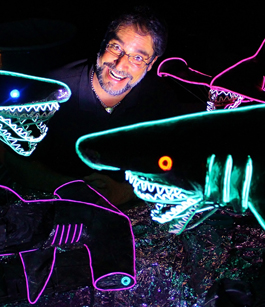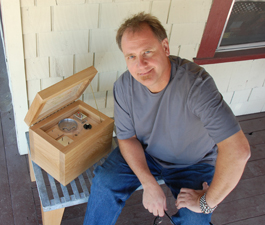home | north bay bohemian index | news | north bay | feature article

Photograph by Chip Scheuer
OALL TEETH: Todd Williams with his remote-control predators.
Hi-Tech Headliners
The Maker Faire's open-source explosion of DIY creativity returns
By Maria Grusauskas and Leilani Clark
The Makers are getting ready. From basements and scattered warehouses in the Oakland hills, from cabins in Occidental all the way down to garages in Santa Cruz, they're putting the finishing touches on their projects for the fast-approaching Maker Faire 2011. Once described as "Burning Man without the nudity," the extravaganza of invention and self-expression poised to erupt on the San Mateo County Fairgrounds May 21-22 is the largest do-it-yourself fair in the world, with over 600 participating crafters, engineers and inventors.
The Maker Faire's hands-on, playground atmosphere provides multigenerational entertainment, but it also serves as a mash-up of knowledge where the most creative minds in the Bay Area meet—and in a forum with a new set of rules. The open-source philosophy of the Maker Faire means that all Makers share their designs with the world. There are no copyrights. There are no profits. As Sherry Huss, general manager and founder of the Maker Faire, puts it, "You can take something from the big pot and work on it, and if you add to it, then you should put it back into the community so other people can work on it. It's not proprietary."
Although this country's cultural tradition is to buy new things made by private corporations, the emerging open-source DIY movement is spreading through our regional hotbed of innovation and technology.
"DIY is so important to the creation of technology. It's unconstrained by bureaucracy and it's fueled by passion instead of profit," says Eric Stackpole, a mechanical engineer who's bringing his telerobotic submarine to the faire. "When people follow their passion, they try things businesses that rely on market research never would, and the kind of communities passionate people end up networking and collaborating with are all like-minded."
Part playground, part science fair, part workshop and part county fair, the Maker Faire is also a famous catalyst where disparate elements meet and new forms of art and technology are born. "When the knitters start talking to the folks from the Grafitti Research Labs, that's when the magic happens," says Huss, referring to the "yarn bombs," or knitted graffiti, that came out of a Maker Faire in New York. Six years after Sebastopol-based O'Reilly Media presented the first Maker Faire, the movement has caught fire—and the possibilities are endless.— Maria Grusauskas
Jaws of Light
Artist and sculptor Todd Williams was in the middle of Nevada's Black Rock Desert when he saw a tumbleweed suspended above a remote-controlled truck. It was 1998, his first year at Burning Man, and the hovering bundle planted a seed of inspiration that would come to fruition years later.
"There's just something so elegant and ridiculous about seeing a tumbleweed floating by instead of tumbling around," says Williams. "I never really thought about putting art on a remote-controlled car before that."
Captivated by another floating object in the desert that week—a two-dimensional neon horse "galloping" over the black sand—he found his fascination deepening. The horse had been fashioned from electroluminescent wire, or "el wire," a new material that was at that time coming out of Israel. Essentially copper wire coated in phosphorescent material, it required only a low voltage charge to glow as if red-hot.
Williams began experimenting, and returned to Burning Man in subsequent years with various el wire art projects—horses, UFOs and "alien bug things," all strapped to remote-controlled monster trucks. For the underwater-themed year of Burning Man, six years after he began working with el wire, he crafted his most popular and intriguing piece of work to date: a four-foot neon shark named Sparky.
"There's juju to it. It's more than just a fish. There's the danger side to it," says Williams. "It's one of the more powerful animals on the planet."
Sparky's skeleton was crafted with wire, welded into a shark-shaped basket and covered with a scaly aluminum screen, papier-mache and paint. (The result, in daylight, is realistic-looking sharkskin.) The final touch was outlining the whole shape with el wire, with segmented jaws, gills and tails lit in succession to create the illusion of breathing and biting. Perched on long metal rods above a remote-controlled vehicle, Sparky "swims" a couple feet off the ground—the perfect height for nibbling at the calves of unsuspecting festivalgoers.
"What started as a toy to play with in the desert for a week turned into a cult favorite," says Williams, who's coming to be known as "the shark guy" and now has four "festival-durable" sharks, two modeled after great white sharks (Sparky and Betty) and two hammerheads (aka "glamorheads"), Hammie and Stella. "You never know what people will do. I've had people run up and tackle them," says Williams. And since most people have never seen a neon shark swimming toward them in the dark, there are thousands of different reactions to be had.
Williams will bring all four of his sharks to the Maker Faire this year, while a life-sized 12-foot shark—one large enough to ride, he says—prowls the far reaches of his imagination. Last year, his sharks were such a hit that he won three blue ribbons; this year he brings not only his sharks but also various pieces of clothing he has been making, naturally, out of el wire.—Maria Grusauskas
Landsharks are Exhibit 415 in the Dark Room of the Fiesta Building. Williams will be running the sharks for 20 minutes on the hour every hour except noon. Get a preview at www.toddwilliamsdesign.com.

Photograph by Alma Shaw
MUSIQUE CONCRETE: Joe Szuecs was inspired by John Cage's prepared piano.
Beat Maker
As the husband to its founder Sherry Huss, Joe Szuecs has been a part of every Maker Faire since it first began in 2006. And while he's known for bowls and flowers made from old records and birdhouses repurposed from used materials, this year he'll be showing off his latest invention, the "New Music Box." Powered by an arduino—a microcontroller that's become a Maker technology favorite—and inspired by John Cage's prepared piano, Szuecs' neat wooden boxes generate percussive beats different than your standard drumset. "The kinds of sounds I go for are a little more abstract," says Szuecs, sitting by the window in sunny Renga Arts, the store and gallery that he's owned for six years.
The beatmaking device, made from recycled parts and featuring decoration by friend and collaborator Laura Paulini, can store up to six rhythms, says Szuecs. Mechanical gadgetry inside the box creates the sounds, which "had people dancing in New York City." Szuecs himself is a jazz guitarist, and eventually he wants to incorporate his beat generators into an actual live performance, composing pieces as Cage did with his piano.
Another piece making its debut at Szuecs' Maker booth is a turntable contraption that allows for multiple records to be played at once, which has a "Charles Ives pedigree to it," he says. Right now, he's in the experimental stage, gutting an old record player and figuring out how to get the right materials for the tone arms. He spends time at thrift stores like Garbage Reincarnation in Santa Rosa's Roseland district, as well as various surplus electronics places, looking for salvageable materials for his work. "I like old knobs," he says.
Renga Arts recently moved from its small Occidental space to this much larger location on Gravenstein Highway, on land shared with West County sculptor Patrick Amiot, the artist behind all those rambunctious metal mermaids and motorcycle riders plunked all over West County. An Amiot piece stands at the entrance to the store (an enormous cow jumping over a moon) while inside, a de facto Maker gallery unfolds with work made from recycled goods. Art made of classroom rulers, bottle caps and discarded pieces of rubber cover most of the surfaces. Wooden birds hang from the ceiling, with wings constructed by Szuecs from salvaged swimming pool liner.
The contents of Renga Arts conjure feelings of possibility and innovation, and Szuecs personifies this attitude. He'll spend the weekend getting ready for the Maker Faire in his workshop, putting the final touches on his music boxes and turntables, making sure everything works well and sounds good.
"This weekend is 'vacuum form experiment,'" Szuecs says, laughing. In classic Maker fashion, it's all about the tinkering, getting gadgets to work, getting his boxes to play those beats, simply for the pure joy of it.—Leilani Clark
The New Music Box is Exhibit 5117 of Area A in the Expo Building. Demonstrations will occur throughout the day. Get a preview at www.rengaarts.com.

Photograph by Felipe Buitrago
THE ABYSS: Eric Stackpole is building robots to dive deep for gold.
Search Engine
Adventurer Eric Stackpole has been burning the candle at both ends. Designing his second remotely operated vehicle for underwater exploration is "just a work of passion," he says, a passion he somehow finds time for when not working on his senior thesis at the University of Santa Clara's school of mechanical engineering.
But dividing his time between school and building robots is one of Stackpole's talents; in fact, while an undergrad at San Jose State, he once built a robot named ESTR that he outfitted with a webcam and sent to attend lectures in his stead, controlling it from his dorm room.
The drive behind his passion is clear: exploration. "In the last 10 years alone, some of the greatest exploration that has been done—missions to the deepest parts of Earth's oceans and the highest latitudes of Mars' poles, and many places in between—has been with telerobots," says Stackpole.
His latest remotely operated vehicle—we'll call it the second OpenRov for now—was inspired by his desire to delve into the mysterious depths of Hall City Cave, a cavern in the mountains of Northern California with a seemingly bottomless water-filled shaft rumored to contain a stash of stolen gold. Although many people have attempted to explore the shaft, no one has ever reached its end.
"Using a home-built OpenROV submarine, I intend to telerobotically explore the parts of this submerged labyrinth that have never been seen by human eyes before," says Stackpole, whose OpenROV features a high-resolution camera on board—part of its mobile device "brain"—and magnetic thrusters that allow it to go to more extreme depths than ROV-1.
But the most notable aspect of Stackpole's new OpenROV is that it is an "open hardware project," meaning that it will be built from materials that can be obtained at tech and hardware stores (rather than commissioned by special companies), and the entire blueprint will be open and free to the public.
"The open hardware movement is just emerging now, but it has huge potential," he says. "The advantages to keeping it open is that the design work is transferable, the cost of development is spread among users and it's shared within a community of people." The one stipulation for the open hardware project is that it always remain in the public domain—all subsequent modifications and improvements in design are to be shared with the community, just as the first design was.
So, a project motivated by an altruistic desire to share the ability to explore the world's mysterious places, and not by patents, copyrights or profits? "Imagine what we could do if the average person had access to serious telerobotic exploration equipment and could conduct expeditions to unknown places on his or her own with the same ease as playing a video game. That's what I envision for OpenROV," says Stackpole.—Maria Grusauskas
OpenROV debuts at Exhibit 38 in the Expo Building. Get updates at www.openROV.com.
The Maker Faire runs Saturday, May 21, 10am-8pm and Sunday, May 22, 10am-6pm at the San Mateo County Fairgrounds, 1346 Saratoga Drive, San Mateo. $5-$25 (children under three years are free) at www.makerfaire.com.
Send a letter to the editor about this story.
|
|
|
|
|
|